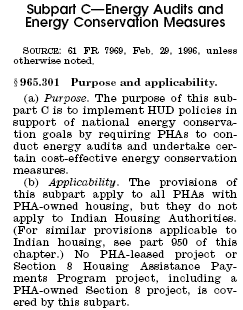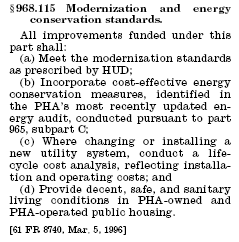Energy Audits
Princeton Engineering Services, PC specializes in Energy Audits and provides Energy conservation analysis & solutions.
The energy audit compares the current cost of utilities, operation, and maintenance of the existing housing stock at your property with a set of proposed new conditions. The proposed Energy Conservation Opportunities (ECO’s) are taken from HUD guidelines and general knowledge of the industry. The estimated cost savings are compared with the implementation costs to determine the relative economic impact of implementing the ECO. Current HUD (Housing & Urban Development) guidance indicates that annual savings of more than one-fifteenth of the implementation cost warrant implementation of the ECO.
Sample Energy Audit Project: Motivation High School
HUD Energy Audit & Conservation and Modernization Requirements
It is important to note that the Code of Federal Regulations (CFR) concerning Energy Audits have been revised. The general rule at 24CFR 965.301 now allows only five years interval between Energy Audits of a facility. Formerly there was no interval, so, many of the Audits from the old rule (dated 1984) are the most current available to Housing Authorities. If any of your energy audits for Low Rent Public Housing structures were completed prior to October 1994, you should budget for new audits because procuring the finished product is likely to take up to a year to complete.
The Modernization specific rule at 24CFR 968.115 refers to the general rule, requiring cost effective opportunities to be pursued when a work item is carried out.


Purpose of Audit
The audits should analyze the "life cycle cost" of an energy saving opportunity. Do not forget the maintenance and repair costs of the options being compared. For example, a change from incandescent to florescent lighting might not be cost effective based on the energy savings. If your staff is spending time replacing the burned out bulbs, the change will be very cost effective because of labor cost savings.
Please note that, while it is not specifically mentioned in the Regulation, a water use audit is strongly recommended. Most of you have seen tremendous percentage increases in water and sewer costs over the last few years. Simple things like pressure reducer valves can save both water and maintenance costs since all the valves in a reduced pressure unit will be under less stress. The flow will be reduced and there will be fewer leaks. Despite fears of high maintenance costs for "low flow" toilets, staffs at several PHAs have reported such fears to be unfounded.
Capital Budgeting
Capital Budgeting is the process by which the owner decides which long-term investments to make. Capital Budgeting projects, i.e., potential long-term investments, are expected to generate cash flows over several years. The decision to accept or reject a Capital Budgeting project depends on an analysis of the cash flows generated by the project and its cost.
The following three Capital Budgeting decision rules will be presented:
• Payback Period
• Net Present Value (NPV)
• Internal Rate of Return (IRR)
A Capital Budgeting decision rule should satisfy the following criteria:
• Must consider all of the project's cash flows.
• Must consider the Time Value of Money
• Must always lead to the correct decision when choosing among Mutually Exclusive Projects
Payback Period
The Payback Period represents the amount of time that it takes for a Capital Budgeting project to recover its initial cost. The use of the Payback Period as a Capital Budgeting decision rule specifies that all independent projects with a Payback Period less than a specified number of years should be accepted. When choosing among mutually exclusive projects, the project with the quickest payback is preferred.
The calculation of the Payback Period is best illustrated with an example. Consider Capital Budgeting project A which yields the following cash flows over its five year life.
| YEAR | Cash Flow |
| 0 | -1000 |
| 1 | 500 |
| 2 | 400 |
| 3 | 300 |
| 4 | 200 |
| 5 | 100 |
To begin the calculation of the Payback Period for project A let's add an additional column to the above table which represents the Net Cash Flow (NCF) for the project in each year.
| YEAR | Cash Flow | Net Cash Flow |
| 0 | -1000 | -1000 |
| 1 | 500 | -500 |
| 2 | 400 | -100 |
| 3 | 300 | 100 |
| 4 | 200 | 300 |
| 5 | 100 | 400 |
Notice that after two years the Net Cash Flow is negative (-1000 + 500 + 400 = -100) while after three years the Net Cash Flow is positive (-1000 + 500 + 400 + 200 = 100). Thus the Payback Period, or breakeven point, occurs sometime during the third year. If we assume that the cash flows occur regularly over the course of the year, the Payback Period can be computed using the following equation:

Thus, the Payback Period for project A can be computed as follows:
| Payback Period |
| Payback Period = 2 + (100)/(200) = 2.5 years |
Thus, the project will recoup its initial investment in 2.5 years.
Net Present Value
The Net Present Value (NPV) of a Capital Budgeting project indicates the expected impact of the project on the value of the firm. Projects with a positive NPV are expected to increase the value of the firm. Thus, the NPV decision rule specifies that all independent projects with a positive NPV should be accepted. When choosing among mutually exclusive projects, the project with the largest (positive) NPV should be selected.
The NPV is calculated as the present value of the project's cash inflows minus the present value of the project's cash outflows. This relationship is expressed by the following formula:
where: CFt = the cash flow at time t and r = the cost of capital.
The example below illustrates the calculation of Net Present Value. Consider Capital Budgeting projects A and B which yield the following cash flows over their five year lives. The cost of capital for the project is 10%.
| YEAR | Project A Cash Flow | Project B Cash Flow |
| 0 | -1000 | -1000 |
| 1 | 500 | 100 |
| 2 | 400 | 200 |
| 3 | 200 | 200 |
| 4 | 200 | 400 |
| 5 | 100 | 700 |
| Net Present Value |
| Project A Project B |
Thus, if Projects A and B are independent projects then both projects should be accepted. On the other hand, if they are mutually exclusive projects then Project A should be chosen since it has the larger NPV.
Internal Rate of Return
The Internal Rate of Return (IRR) of a Capital Budgeting project is the discount rate at which the Net Present Value (NPV) of a project equals zero. The IRR decision rule specifies that all independent projects with an IRR greater than the cost of capital should be accepted. When choosing among mutually exclusive projects, the project with the highest IRR should be selected (as long as the IRR is greater than the cost of capital).
where: CFt = the cash flow at time t.
The determination of the IRR for a project, generally, involves trial and error or a numerical technique. Fortunately, financial calculators greatly simplify this process.
The example below illustrates the determination of IRR. Consider Capital Budgeting projects A and B which yield the following cash flows over their five year lives. The cost of capital for both projects is 10%.
| YEAR | Project A Cash Flow | Project B Cash Flow |
| 0 | -1000 | -1000 |
| 1 | 500 | 100 |
| 2 | 400 | 200 |
| 3 | 200 | 200 |
| 4 | 200 | 400 |
| 5 | 100 | 700 |
| Internal Rate of Return |
Project A Project B  |
Thus, if Projects A snd B are independent projects then both projects should be accepted since their IRRs are greater than the cost of capital. On the other hand, if they are mutually exclusive projects then Project A should be chosen since it has the higher IRR.
Energy conservation analysis & solutions
Princeton Engineering Services PC provides energy conservation analysis and energy conservation engineering solutions for new and existing heating, ventilation, air conditioning and refrigeration (HVAC) systems. We can provide comprehensive as well as specialty audits of individual systems such as variable speed drives.
Energy conservation analysis by Princeton Engineering Services
PES's energy conservation analysis and engineering solutions have saved our customers thousands of dollars in utility costs in addition to creating to positive environmental impact.
Being a small firm specializing HVAC engineering, PES brings the advantage of customization, and individual attention to every energy conservation analysis and energy conservation-engineering project we take on. In many cases we have developed customized testing and data gathering equipment to analyze individual problems and help improve energy conservation within site-specific systems.
Princeton Engineering Services, PC also offers extensive knowledge of rebate and subsidy programs offered by utility companies that can partly or completely offset the cost of major renovations and energy conservation measures.
In the past we have provided energy conservation analysis and energy conservation engineering solutions to companies and institutions in both the private and public sector and for industries as varied as health care, government, education, manufacturing, and high-tech.
Energy conservation analysis success stories
We have overseen energy conservation analysis projects totaling close to 5 million dollars, and implemented control systems which measured, calculated and assigned energy use in real time.
We offer fast track energy conservation analysis to contractors, architects, engineers, managers and real estate firms and with a proven track record in energy conservation analysis, engineering design, troubleshooting, and industrial controls engineering, our team of engineers represents a combined total of 20 years experience with HVAC systems. We provide walk a through, comprehensive or specialty audits for specific systems such as heating, air conditioning, variable speed drives, etc.
Trouble Shooting Process Consists of Three Steps
Step 1
First we perform a thorough walk through where we meet with you and your staff in order to better understand the nature of your problem, the requirements that the solution must meet as well as the best approach to resolving the problem.
Step 2
Next we perform comprehensive energy audit in which we gather detailed information using specialized instrumentation and techniques, many of which we have custom built and designed ourselves.
Step 3
Finally we deliver a detailed report and executive summary complete with simplified text, graphs and charts to guide you through each stage of the correction and implementation process. We have, in many cases, remained on throughout the implementation process to provide construction documents and administration.